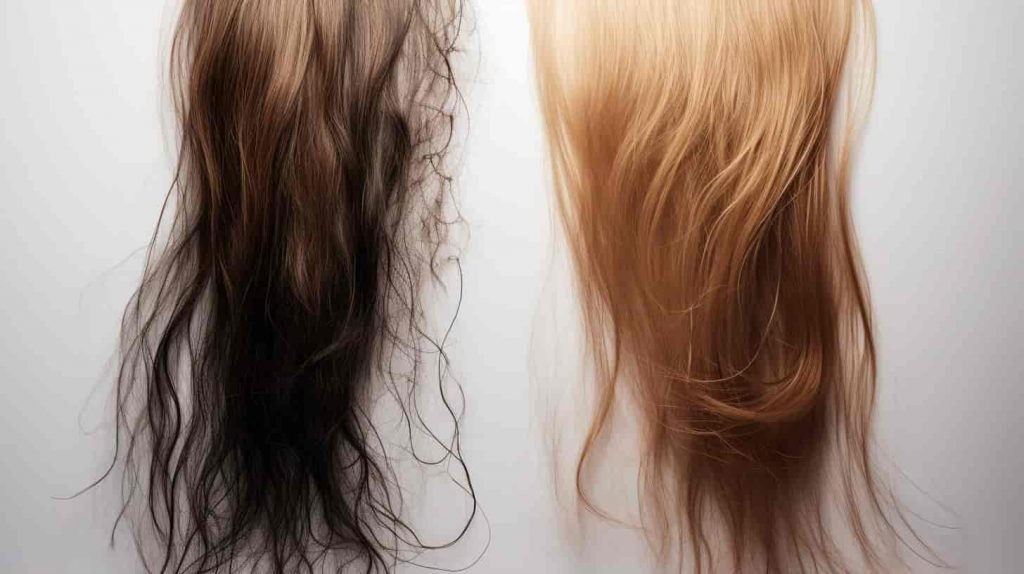The common belief that damaged hair dries slower may not fully capture the complex nature of how hair interacts with moisture. When hair is damaged, its cuticle layer is compromised, increasing porosity. This means it can both absorb and release moisture quicker than healthy hair. This insight prompts us to question the relationship between hair damage, porosity, and drying times, suggesting a more complicated link than previously thought. As we investigate further, it's clear that the connection between hair damage and drying times invites a thorough examination of the mechanisms involved, pushing us to rethink our approaches to daily hair care.
Table of Contents

The Impact of Damage
Grasping how damage affects hair structure is key to predicting drying times and maintaining hair health. Contrary to popular belief:
- Damaged hair, marked by higher porosity, often dries quickly.
- Porous cuticles allow water to be absorbed more rapidly, reducing drying time.
- Loss of moisture due to cuticle damage speeds up the drying process.
- Chemical and heat damage change the hair's structure, influencing how quickly it dries.
Factors Affecting Drying Time
Several factors impact how long hair is to dry, including hair porosity, chemical treatments, and environmental exposure. Damaged hair, which is more porous and may have split ends, tends to lose moisture faster. Thus, the nature of the hair and its health condition are significant in determining drying time. Achieving healthy hair can affect drying duration.
Protecting Your Hair
Protecting damaged hair requires a comprehensive strategy that involves choosing the right hair care products and treatments to keep moisture levels balanced and prevent further damage. This careful approach is vital for hair that takes a long time to dry or dries quickly, aiming for healthier hair over time. Key practices include:
- Using products that protect against heat.
- Reducing the use of high-heat styling tools.
- Applying conditioners that don't need to be rinsed out.
- Using hair masks specially formulated for damaged hair.
Speeding Up Drying Process
Protecting damaged hair is important, but you can still speed up the drying process without harming it. Using quick-dry sprays such as Oribe Royal Blowout or Color Wow Speed-Dry, along with microfiber towels, can significantly reduce drying time. It's also effective to let your hair partially air dry before finishing up with a diffuser, especially on longer sections. Remember, taking longer to dry isn't a problem but a sign of healthier hair practices.
Frequently Asked Questions
How Does the Structure of Damaged Hair Affect Its Drying Time?
The structure of damaged hair, specifically compromised cuticles, affects its drying time. Damaged cuticles allow for increased moisture loss, resulting in longer drying times. Additionally, heat damage can further hinder the drying process.
What Role Does Porosity Play in How Damaged Hair Absorbs and Releases Moisture?
Porosity significantly affects how damaged hair absorbs and releases moisture. Hair with high porosity due to a compromised cuticle absorbs water quickly but loses moisture rapidly. This can result in longer drying times and struggles with hydration. Additionally, split ends can further impact drying time.
How Does Damaged Hair Struggle With Moisture Retention and Hydration?
Damaged hair struggles with moisture retention and hydration. The compromised cuticle escapes moisture, leading to dry and brittle hair. Deep conditioning is essential for restoring moisture. Using hair products that promote moisture retention can also help.
Does Hair Density and Thickness Impact the Drying Time of Damaged Hair?
Hair density and thickness can impact the drying time of damaged hair. Thinner hair allows for faster drying due to increased air circulation. However, excessive hair breakage or thinning should be addressed through a proper hair care routine to promote healthy hair growth and maintain overall health.
How Does Having Split Ends Contribute to Slower Drying Time in Damaged Hair?
Split ends in damaged hair contribute to slower drying time due to their impact on hair structure and porosity. They create gaps in the cuticle, increasing moisture loss and reducing retention. Hair density also affects drying time.
References:
Hair Shaft Damage from Heat and Drying Time of Hair Dryer

